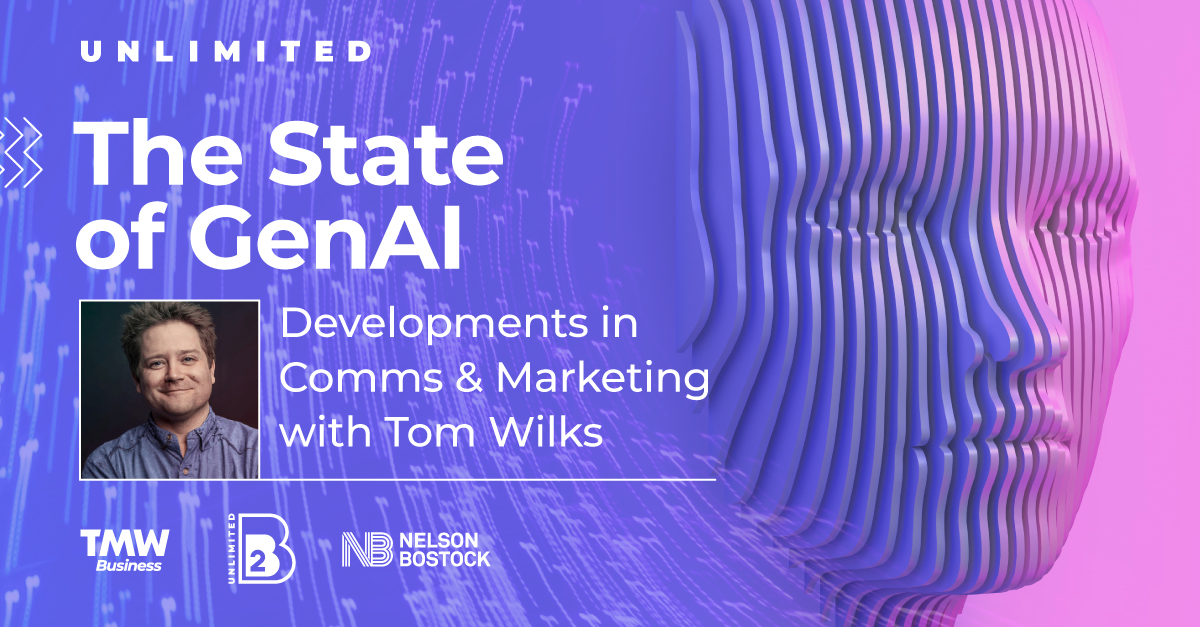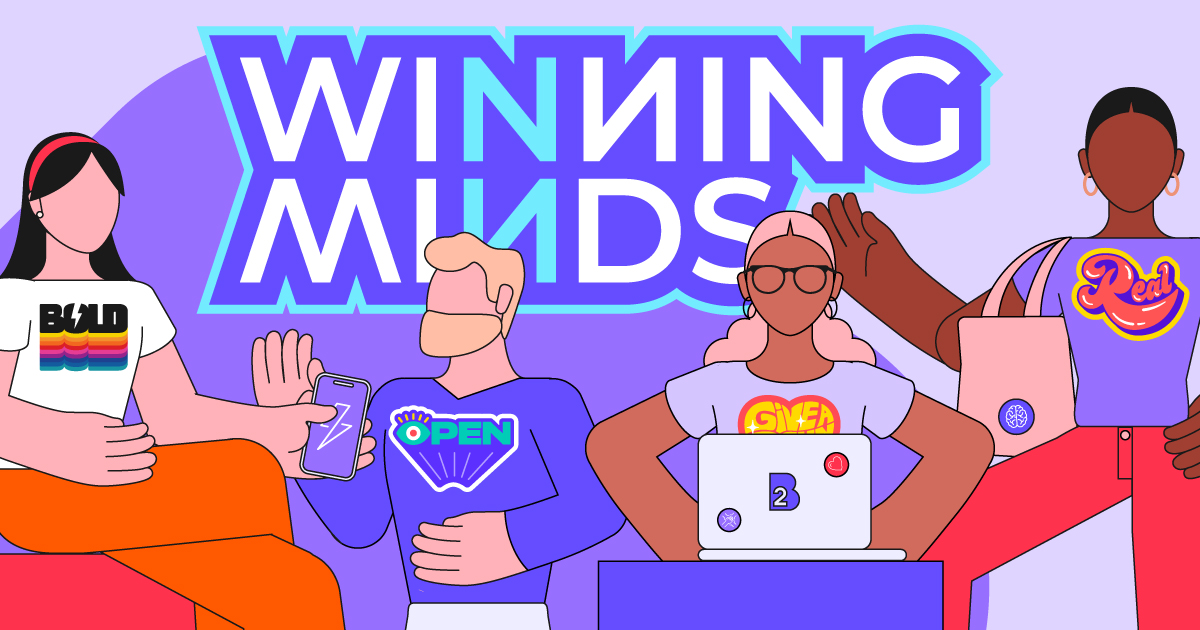As we gear up to host the next chapter in our Humans vs Robots event series, we had the opportunity to sit down with our Group CTO, Tom Wilks, for an insightful discussion on AI trends. Our conversation covered recent advancements and shifts, practical applications, and the ways in which businesses are adapting to its integration since our last event in November.
Across marketing and communications, leaders are shifting from cautious observation to active engagement with GenAI. This progression prompts crucial questions about the evolving partnership between humans and GenAI: What strategies ensure a positive-sum relationship? How can organisations steer clear of the common missteps in AI adoption?
Read on to find out Tom’s perspective on these questions, and what the future holds for human-AI collaboration in the industry.
Tom, since our last Humans vs. Robots event, how has the GenAI landscape evolved, particularly in the context of marketing and communications?
In terms of AI development, five months can seem like a lifetime. Major players like OpenAI and Google have been quick to flex their latest and upcoming capabilities for 2024, albeit with a couple of notable missteps along the way. The marketing and communications industry is in the spotlight here as the rapid release of new platforms and tools directly impacts our everyday work – OpenAI’s soon-to-be-released Sora video generation platform being a prime example. These developments are nudging leaders in our industry to pay heed and consider accelerating the integration of these technologies into their strategies. Although there’s a natural inclination to proceed with caution, the fast-paced nature of GenAI advancements often means making important decisions with less-than-complete information. It’s really hard to build a coherent long-term strategy when you know that the ground is going to be continually shifting underneath you.
Reflecting on the transition from ‘Experimenting with GenAI’ to ‘Strategising with GenAI,’ could you share insights on why a strategic approach is becoming increasingly important for businesses?
Tech companies and startups are intensely vying to own this space – the competition is only going to increase and it’s an unenviable task to pick the winners. For brands adopting AI capabilities, this makes it challenging to commit to a single platform or strategy. The wisest option is to take a flexible yet strategic approach to GenAI adoption.
As we shift from a ‘toe in the water’ to a more deliberate strategy phase, businesses need to be agile in their adoption of GenAI capabilities, while also ensuring their efforts are aligned with overarching business objectives.
As we shift from a ‘toe in the water’ to a more deliberate strategy phase, businesses need to be agile in their adoption of GenAI capabilities, while also ensuring their efforts are aligned with overarching business objectives. A strategic approach helps to concentrate resources on initiatives that promise the most significant impact as opposed to scattering efforts across disparate projects. Given the rapid pace of advancements in AI, incorporating flexibility into these strategic plans is crucial to adapt to the technological shifts that could render certain strategies obsolete in just a few months.
Can you elaborate on the potential risks and opportunities for clients who either adopt or ignore a strategic approach to GenAI in their marketing efforts?
From an internal perspective, I’d encourage marketing leaders to think broadly about GenAI use cases. Content creation has been an obvious area of focus thus far. However, companies may also find there’s huge value in implementing GenAI tools to enhance their team’s ability to understand and access information swiftly, massively reducing the time necessary to get from intention to result. Focusing on time-saving and better resource allocation allows for the setting of clear objectives and success metrics across the organisation.
On the customer front, AI introduces the capability for personalisation at an unprecedented scale. Brands can achieve personalised engagement with their audience – such as tailoring messages to different audience demographics or geographies – without sacrificing reach, effectively addressing a dilemma that has long challenged marketers. The potential for creating personalised customer interactions without losing the ability to communicate broadly represents a significant leap forward in how we think about customer engagement.
However, the journey towards leveraging AI strategically is not without its risks. The expansive potential of GenAI means it can be applied across a range of areas within an organisation, leading to the possibility of efforts becoming fragmented. This is a digital transformation challenge that any large organisation will be familiar with. Without a unified strategic approach, teams might pursue individual goals with AI, leading to initiatives that, while meaningful in isolation, may not contribute to the overarching business objectives and could be challenging to measure for impact.
With AI’s capabilities continually evolving, how should companies prepare their marketing teams to harness GenAI effectively and ethically?
It’s vitally important for marketing teams to become technologically proficient in navigating GenAI while also staying true to high ethical standards. The first step towards effective preparation involves carefully aligning AI tools with their intended purposes. High expectations met with basic AI tools or simplistic prompts often lead to underwhelming results. This reality highlights the critical nature of choosing the right tools for specific marketing goals and ensuring the team has the necessary skills to fully exploit these technologies.
Moreover, the evolving regulatory environment, alongside ethical considerations around data use, emphasises the need for responsibly navigating GenAI implementation. These factors underscore the importance of adopting a stance of transparency and accountability when deploying new technologies. In a time when AI misuse can significantly damage a brand’s reputation, it’s crucial to openly acknowledge the capabilities and limitations of GenAI initiatives and accept responsibility for their outcomes.
Respecting the ownership of content used in AI models – especially custom models you’re developing in-house – poses another ethical challenge. As the industry seeks a balance between utilising AI for content generation and recognising intellectual property rights, finding a sustainable middle ground that respects creators’ rights while encouraging innovation is a necessity.
Based on your experience, what are some persistent misconceptions about AI in marketing that you’d like to dispel?
A common misconception that continues to surface is the belief that AI tools offer a one-size-fits-all solution. This couldn’t be further from the truth. The reality is that the effectiveness of AI in marketing is deeply contingent upon selecting the right tools tailored to specific objectives and harnessing those tools to their utmost capacity. This misunderstanding highlights an urgent need for education and strategic thinking within the industry.
Many approach GenAI with the expectation that any tool can automatically adapt to any marketing challenge, which leads to disappointment when results don’t meet expectations. Adopting AI alone won’t solve your marketing challenges; it’s about integrating it thoughtfully and strategically into marketing practices to address specific problems and achieve defined goals.
Another overlooked aspect is the dynamic and evolving nature of AI technologies themselves. What works today may not be the best solution tomorrow, and what’s designed for one purpose might not be effective for another. Marketing professionals need to stay informed about the latest developments in GenAI technologies, understand their unique strengths and limitations, and be willing to turn their hand to new tools as they become available.
Finally, looking towards the future, how do you envision the role of human creativity and insight evolving in partnership with GenAI technologies?
The future of human creativity and GenAI technologies is equally thrilling and complex. From what we’ve experienced over the past year or so, it’s clear that our relationship with AI will not follow a linear path. Instead, we should anticipate cycles of acceptance and scepticism as AI’s capabilities continue to expand at an astonishing rate, with new breakthroughs emerging every 6-9 months. This rhythm of rapid advancement and integration will naturally bring its share of challenges, underlining the fact that our journey with GenAI will be tumultuous, marked by both incredible highs and inevitable lows.
Despite these challenges, the possibilities are boundless and offer a source of great excitement. Identifying where AI can be used as a force multiplier for human efforts will not only enhance the scope of what we can achieve but also elevate the quality of our creative outputs.
In the end, I envision a future where this partnership between human creativity and GenAI technologies creates a fertile ground for innovation and greater job satisfaction. The path may not always be smooth, but the potential for transforming how we tackle problems and find creative solutions is truly immense.
===
As we look forward to exploring these themes further and uncovering new frontiers at the Humans vs Robots 3 event on Thursday 2nd May, 8:45-10:30am, we invite you to join us in this exciting journey. This is your opportunity to engage with those exploring and innovating at the forefront of GenAI and marketing. Whether you’re seeking to refine your strategy, discover the latest trends, or simply be inspired by the potential of GenAI, this promises to be a must-attend event for brands and professionals. Register now for Humans vs Robots 3 and secure your spot.












